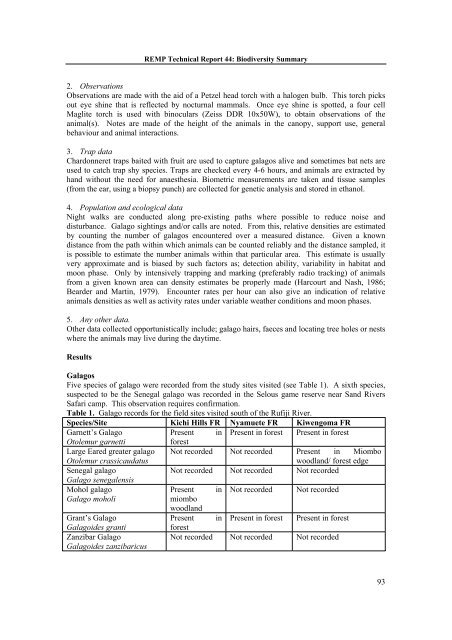Family / Scientific name - Coastal Forests of Kenya and Tanzania
Family / Scientific name - Coastal Forests of Kenya and Tanzania
Family / Scientific name - Coastal Forests of Kenya and Tanzania
Create successful ePaper yourself
Turn your PDF publications into a flip-book with our unique Google optimized e-Paper software.
REMP Technical Report 44: Biodiversity Summary<br />
2. Observations<br />
Observations are made with the aid <strong>of</strong> a Petzel head torch with a halogen bulb. This torch picks<br />
out eye shine that is reflected by nocturnal mammals. Once eye shine is spotted, a four cell<br />
Maglite torch is used with binoculars (Zeiss DDR 10x50W), to obtain observations <strong>of</strong> the<br />
animal(s). Notes are made <strong>of</strong> the height <strong>of</strong> the animals in the canopy, support use, general<br />
behaviour <strong>and</strong> animal interactions.<br />
3. Trap data<br />
Chardonneret traps baited with fruit are used to capture galagos alive <strong>and</strong> sometimes bat nets are<br />
used to catch trap shy species. Traps are checked every 4-6 hours, <strong>and</strong> animals are extracted by<br />
h<strong>and</strong> without the need for anaesthesia. Biometric measurements are taken <strong>and</strong> tissue samples<br />
(from the ear, using a biopsy punch) are collected for genetic analysis <strong>and</strong> stored in ethanol.<br />
4. Population <strong>and</strong> ecological data<br />
Night walks are conducted along pre-existing paths where possible to reduce noise <strong>and</strong><br />
disturbance. Galago sightings <strong>and</strong>/or calls are noted. From this, relative densities are estimated<br />
by counting the number <strong>of</strong> galagos encountered over a measured distance. Given a known<br />
distance from the path within which animals can be counted reliably <strong>and</strong> the distance sampled, it<br />
is possible to estimate the number animals within that particular area. This estimate is usually<br />
very approximate <strong>and</strong> is biased by such factors as; detection ability, variability in habitat <strong>and</strong><br />
moon phase. Only by intensively trapping <strong>and</strong> marking (preferably radio tracking) <strong>of</strong> animals<br />
from a given known area can density estimates be properly made (Harcourt <strong>and</strong> Nash, 1986;<br />
Bearder <strong>and</strong> Martin, 1979). Encounter rates per hour can also give an indication <strong>of</strong> relative<br />
animals densities as well as activity rates under variable weather conditions <strong>and</strong> moon phases.<br />
5. Any other data.<br />
Other data collected opportunistically include; galago hairs, faeces <strong>and</strong> locating tree holes or nests<br />
where the animals may live during the daytime.<br />
Results<br />
Galagos<br />
Five species <strong>of</strong> galago were recorded from the study sites visited (see Table 1). A sixth species,<br />
suspected to be the Senegal galago was recorded in the Selous game reserve near S<strong>and</strong> Rivers<br />
Safari camp. This observation requires confirmation.<br />
Table 1. Galago records for the field sites visited south <strong>of</strong> the Rufiji River.<br />
Species/Site Kichi Hills FR Nyamuete FR Kiwengoma FR<br />
Garnett’s Galago<br />
Present in Present in forest Present in forest<br />
Otolemur garnetti<br />
forest<br />
Large Eared greater galago Not recorded Not recorded Present in Miombo<br />
Otolemur crassicaudatus<br />
woodl<strong>and</strong>/ forest edge<br />
Senegal galago<br />
Not recorded Not recorded Not recorded<br />
Galago senegalensis<br />
Mohol galago<br />
Galago moholi<br />
Grant’s Galago<br />
Galagoides granti<br />
Zanzibar Galago<br />
Galagoides zanzibaricus<br />
Present<br />
miombo<br />
woodl<strong>and</strong><br />
in Not recorded Not recorded<br />
Present<br />
forest<br />
in Present in forest Present in forest<br />
Not recorded Not recorded Not recorded<br />
93

















